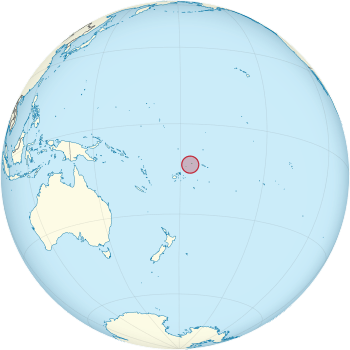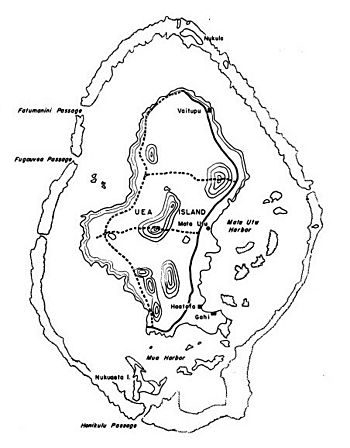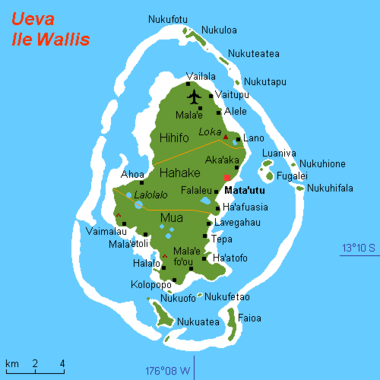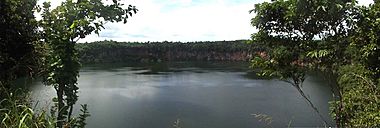Wallis (island) facts for kids
Quick facts for kids
Kingdom of ʻUvea
Puleʻaga Hau ʻo ʻUvea
|
|
|---|---|
 |
|

Detailed map of the island
|
|
| Capital and largest city
|
Matāʻutu 13°16′S 176°12′W / 13.267°S 176.200°W |
| Official languages | |
| Demonym(s) | Wallisian |
| Government | Overseas collectivity |
|
• King (Lavelua)
|
Patalione Kanimoa |
|
• Prime Minister (Kalae Kivalu)
|
Setefano Hanisi |
|
• Bishop of Diocese
|
Susitino Sionepoe |
| Traditional customary kingdom | |
| 29 July 1961 | |
| Area | |
|
• Total
|
96 km2 (37 sq mi) (211th) |
|
• Water (%)
|
negligible |
| Population | |
|
• 2018 census
|
8,333 |
|
• Density
|
11,136/km2 (28,842.1/sq mi) |
| Currency | CFP franc |
| Time zone | UTC+12 |
| Driving side | right |
| Calling code | +681 |
| Internet TLD | .wf |
Wallis (in Wallisian: ʻUvea) is a beautiful Polynesian island in the Pacific Ocean. It is part of the Wallis and Futuna islands, which are a French overseas territory. Wallis is located north of Tonga and northeast of Fiji. The island covers about 100 square kilometers (39 square miles) and is home to 8,333 people. Its capital city is Matāʻutu.
Wallis is a volcanic island with rich, fertile soil. It has many lakes and gets a lot of rain. The highest point on the island is Mount Lulu Fakahega, which is 131 meters (430 feet) tall. Most people on Wallis are Roman Catholic.
The island was once part of the Tu'i Tonga Empire, a powerful maritime empire from the 13th to 16th centuries. Later, Captain Samuel Wallis, a navigator from Cornwall, England, saw the island in 1767. He named it "Wallis" after himself. In 1842, the people of Wallis asked France for protection. A treaty was signed in 1887, making it a French protectorate. After a public vote in 1959, Wallis officially became a French Overseas Territory in 1961.
Contents
Exploring Wallis's Geography
Wallis Island is about 77.5 square kilometers (30 square miles) in size. Its coastline is about 50 kilometers (31 miles) long. The island has several large crater lakes, like Lake Lalolalo. These lakes show that the island was formed by volcanoes. Some lakes, such as Lalolalo and Lanu'tavake, are almost perfect circles with steep sides.
Wallis Island is located 240 kilometers (150 miles) northeast of Futuna and Alofi. These islands form the Hoorn archipelago. Wallis Island is surrounded by about 15 smaller islands, all protected by a large barrier reef. This group of islands makes up the Wallis archipelago. The island's fertile soil and good rainfall help people grow food for themselves.
Districts of Wallis Island
Wallis is divided into three main areas, called districts. They are arranged from north to south:
- Hihifo: This district has 5 villages: Vailala, Tufuone, Vaitupu, Malae, and Alele.
- Hahake: This district has 6 villages: Liku, Aka'aka, Mata-Utu, Ahoa, Falaleu, and Ha'afuasia.
- Mu'a: This district has 10 villages: Lavegahau, Tepa, Gahi, Ha’atofo, Mala’efo’ou, Kolopo, Halalo, Utufua, Vaimalau, and Teesi.
| District ("meaning") | Capital | Area (km²) |
Population (2003 census) |
Villages |
|---|---|---|---|---|
| Hihifo ("West") | Vaitupu | 23.4 | 2422 | 5 |
| Hahake ("East") | Matāʻutu | 27.8 | 3950 | 6 |
| Mu'a ("First") | Mala'efo'ouA | 26.3 | 3699 | 10 |
| 'Uvea (Wallis) chiefdom | Matāʻutu | 77.5 | 10071 | 21 |
A Formerly called "Mua".
Wallis's Tropical Climate
Wallis has a hot and humid climate due to trade winds. The average temperature is about 26°C (79°F) all year. It rarely drops below 24°C (75°F). During the rainy season, temperatures can reach 28°C to 32°C (82°F to 90°F).
The island gets a lot of rain, between 2500 and 3000 mm (98 to 118 inches) per year. It can rain for at least 260 days a year, and the air is very humid (80%). The rainy season is from November to April. This is also when strong tropical cyclones can pass over the islands. From May to October or December, the weather is cooler and drier because of winds from the southeast.
Climate Change Concerns
Even though Wallis is not expected to be completely covered by water, rising sea levels are a concern. Most people on the island live in areas close to the coast. These coastal settlements could be affected by the rising waters.
A Glimpse into Wallis's History
Archaeological digs show that people lived on Wallis as early as 1400 AD. The island was an important part of the Tu'i Tonga Empire from the 13th to 16th centuries. As the empire's power lessened, Wallis became important on its own. Some high-ranking Tongan families today have roots in Wallis. A famous large canoe called the Lomipeau was built on Wallis as a gift for the Tuʻi Tonga ruler.
The large fortress of Talietumu, near Lotoalahi in the Mua district, was the last place where the Tongans held out before they were defeated. The ruins of this fortress are still a popular place for tourists to visit.
As mentioned, Captain Samuel Wallis saw the island in 1767 after discovering Tahiti. He named it "Wallis." In 1842, the leaders of Wallis Island asked France for protection. A treaty was signed in April 1887, making Wallis a French protectorate.
During World War II, the island's government was aligned with a different French government until a Free French ship from New Caledonia arrived in May 1942. Soon after, in May 1942, soldiers from the United States Marine Corps landed on Wallis. After a public vote in 1959, Wallis became a French Overseas Territory in 1961.
People of Wallis
In 2018, the population of Wallis Island was 8,333 people. This is about 72% of all the people living in Wallis and Futuna. Most people on Wallis speak ʻUvean, also known as Wallisian, as their first language.
Culture and Faith
In Wallis, culture (Aga'ifenua) and religion (Lotu) are very closely connected. Daily life is strongly shaped by Polynesian traditions and by the celebrations of the Roman Catholic faith. Every village has its own special saint. Each district has a large church, and the main church is the Cathedral of Mata-Utu. Almost everyone on the island is Roman Catholic, and there are many religious buildings.
When Catholic missionaries first arrived, they were welcomed by King Vaimua Lavelua. He was later baptized "Soane-Patita Vaimua." Bishop Bataillon became good friends with the royal families. As a trusted advisor to Queen Amelia, he started the Lano Seminary in 1847. This was the first Catholic seminary in all of Oceania.
In 1997, Lano celebrated its 150th anniversary. Important guests, including Samoan Cardinal Pio Taofinu'u, who studied there, came for the celebration. Large groups from Tonga, Samoa, Fiji, and New Caledonia also attended. Wallis and Futuna became an Apostolic Vicariate (a type of church district) in 1935 and a full Diocese in 1966.
Getting Around Wallis
The only commercial flights to Wallis are operated by Aircalin, an airline based in New Caledonia. Aircalin has an office in Matāʻutu, in the Hahake district.
Learning on Wallis
Wallis Island has a good education system. There are 12 primary schools for younger students. For older students, there are four junior high schools (called collèges) and one senior high school/sixth-form college.
- Junior high schools in Wallis include: Mataotama de Malae, Alofivai de Lano, Vaimoana de Lavegahau, and Tinemui de Teesi.
- The senior high school is called Lycée d'Etat de Wallis et Futuna.
Wallis Museums
The Uvea Museum Association is a private museum located in Mata-Utu. It helps people learn about the history of World War II on the island.
Notable People from Wallis
- Ilaïsaane Lauouvéa - a politician in New Caledonia.
|
See also
 In Spanish: Isla Wallis para niños
In Spanish: Isla Wallis para niños






